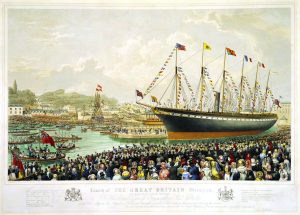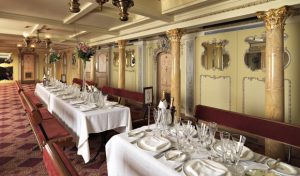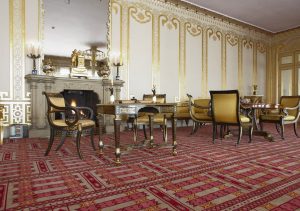Reproduction Carpet Aboard the SS Great Britain
Every January, the first-year fellows of the Winterthur Program and several students in MA and PhD programs from the University of Delaware take part in British Design History: a three-week course on design and material culture with one week at Winterthur and a two-week field study in Great Britain. Traveling to cities including London, Stoke-on-Trent, and Bath, the students have an opportunity to study American Material Culture within a greater global context. Students’ posts in this section are centered on their experiences in England or working with British objects in the Winterthur collection.

Launch of the Great Britain, Lithograph based on the painting by Joseph Walter, c. 1843. Courtesy SS Great Britain Trust.
Towards the end of our British Design History trip, our class spent a day and a half in the port city of Bristol, located on the southwest coast of England. Our first site visit in this city was the SS Great Britain: the world’s first great luxury ocean liner, designed by the great British engineer Isambard Kingdom Brunel in the 1840s. Although the SS Great Britain remained in use for nearly a century, by the mid-20th century it had been abandoned and left to rust. In the 1970s, the ship was rescued and returned to Bristol as one of the city’s most important pieces of cultural heritage. Brunel’s SS Great Britain was painstakingly conserved, and many of its interiors have now been recreated.

The recreated First-class Dining Room on Brunel’s SS Great Britain, Bristol. Courtesy of Brunel’s SS Great Britain.
The most luxurious of these interiors is the first-class dining saloon, whose rich palette of creams, burgundy and gold contrasts starkly with the whitewashed walls of the steerage bunks. While visiting the dining saloon, I found myself sitting on one of the velvet-upholstered benches (seen above) and staring down at the richly-patterned carpet beneath my feet. The carpet’s purples, mauves and creams suited the room perfectly, and its geometric pattern had me transfixed as I attempted to sketch the design in my trip sketch book.
Here I must make a confession: I have a deep dislike for reproduction carpet. As a lifelong fan of historic house sites, I feel guilty to admit that I would almost always rather see visitors stepping on a shabby, worn out original carpet – or no carpet at all – than on a garishly-hued historic reproduction. The contrast of the new with the old seems particularly harsh in the busy, wall-to-wall patterns of a recently-made carpet and, for me, this can shatter the delicate magic of an old interior: it’s as if Elvis’s decorator has suddenly been allowed into my historic encounter.
Not so, however, in the dining room of the SS Great Britain. As I examined the carpet, I realized not only that I liked it but also that it looked like it could have been original (a true feat given the fact that the entire interior of the ship is a reproduction.) I was delighted when our tour guide mentioned that the carpet had been produced by a company called Wilton, which had been able to create a perfect reproduction for the ship because the same company had also made the original carpet for the ship in the 1840s. I fell in love with Wilton on the spot, and as soon as I got home I began to research the company.

Loom at Wilton Carpets producing its signature Wilton Weave woolen carpet in a historic pattern. Image courtesy of Wilton Carpets.
The history of Wilton carpet goes back to the mid-17th century, when a carpet factory was first built in the town of Wilton. The town became well-known for its special weave of woolen carpet in the mid-eighteenth century, when a method was developed to cut the loops of a Brussels-style weave, creating a nap. In the nineteenth century, Wilton carpet exhibited its wares at the Great Exhibition in 1851, and it remained active into the late-20th century, when it was bought out. The current Wilton Carpets reopened in 1995, and still uses the same techniques, materials (wool from British sheep) and, in some cases, looms, that have been used to produce Wilton carpet for centuries. They have produced reproduction carpets for many historic sites, including Brighton Pavilion.

The Music Room Gallery at The Royal Pavilion at Brighton, featuring bespoke Wilton carpet that carefully reproduces the original 1821 pattern.
Aboard the SS Great Britain, I learned a powerful lesson that I plan to keep with me for the rest of my historic-house-touring days: not all reproduction carpet is bad reproduction carpet. It makes a difference to know that you are standing on a carpet with a centuries-old heritage of craftsmanship, a product that could have been made exactly the same way over a hundred years ago.
See more images of Wilton Carpets’ historic reproductions at their website: https://wiltoncarpets.com/sector/historic-and-heritage-carpet
By Kate Budzyn, WPAMC Class of 2019

Leave a Reply